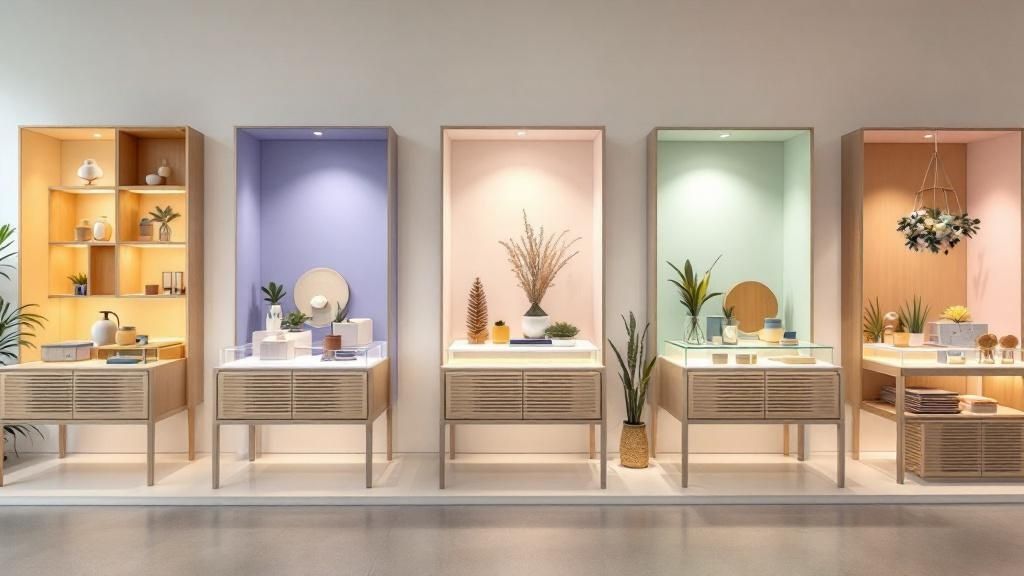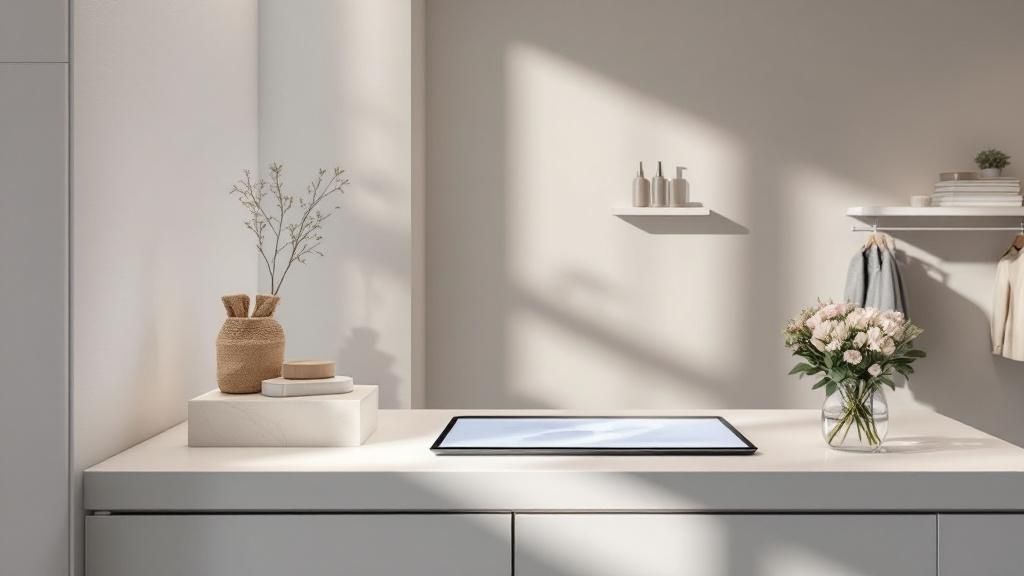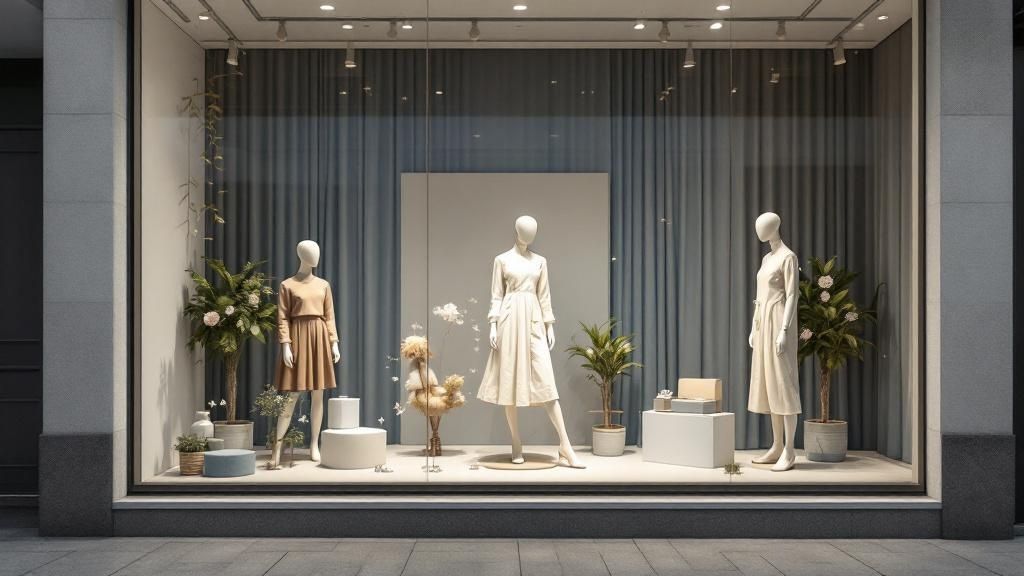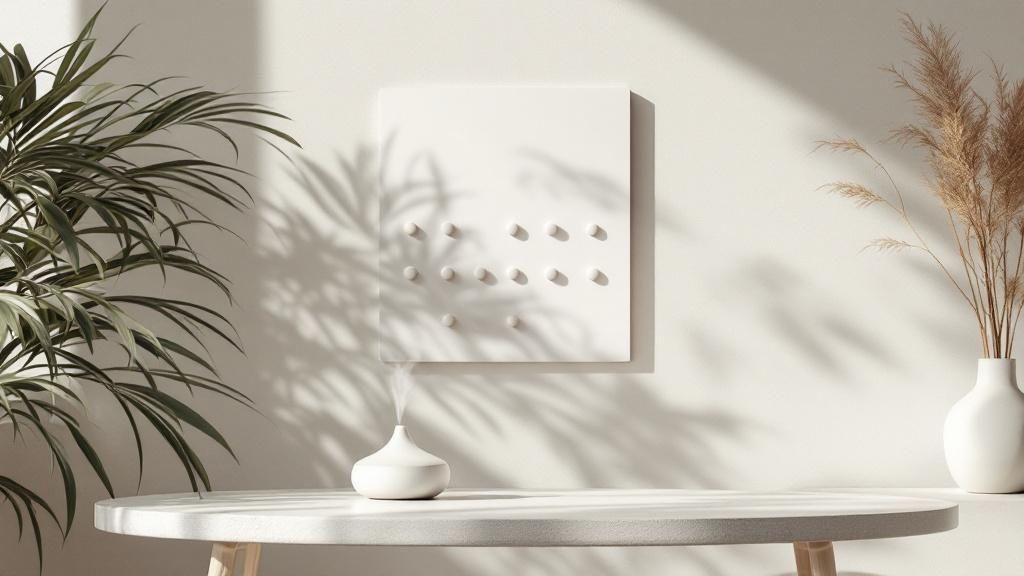Your cart is currently empty.

In today's competitive retail landscape, capturing customer attention is more critical than ever. The moment a customer walks into your store, your displays begin a silent conversation, telling your brand's story and guiding their journey. Stale, uninspired layouts can lead to missed opportunities, while innovative merchandising can turn casual browsers into loyal customers. It is no longer enough to simply place products on a shelf; retailers must create immersive experiences that engage the senses, spark curiosity, and make shopping memorable.
The right display strategy doesn't just showcase what you sell, it communicates why it matters. This guide explores 10 powerful and creative retail display ideas designed to help New Zealand retailers captivate their audience, enhance their brand's narrative, and ultimately drive sales. Whether you operate a small boutique or a large department centre, these concepts offer practical, actionable insights to revitalise your space and create an unforgettable shopping environment. To see a real-world example of how creative displays can transform a public retail space, consider companies specialising in innovative mall installations.
From interactive digital screens and living product demonstrations to storytelling window arrangements and sensory experiences, you will discover fresh approaches to visual merchandising. We will delve into specific, implementable strategies covering everything from modular systems and sustainable materials to technology integration. Let's dive into the strategies that will set your store apart and transform your physical space into a dynamic and engaging brand destination.
1. Interactive Digital Displays
Merging the physical and digital worlds, interactive digital displays transform passive browsing into an active, memorable brand engagement. These displays use technology like touchscreens, augmented reality (AR), and motion sensors to allow customers to explore, customise, and experience products in ways that traditional static displays cannot. This hands-on approach is a powerful tool for modern retailers looking to create a "phygital" environment that captivates and informs.

This method elevates the shopping experience by providing valuable information on demand and creating a sense of play. For instance, a customer could use a touch screen to view a piece of furniture in different colours and fabrics, or use an AR mirror to virtually try on clothing without entering a fitting room. These creative retail display ideas not only boost engagement but also streamline the decision-making process for shoppers.
How to Implement Interactive Digital Displays
Successfully integrating this technology requires a focus on user experience and brand alignment. The goal is to make the interaction feel natural and genuinely helpful, not gimmicky.
- Choose the Right Technology: Consider what best serves your products and customers. Beauty brands like Sephora use AR "Virtual Artist" mirrors for makeup try-ons, while athletic stores like Nike have used interactive walls for sneaker customisation.
- Prioritise Intuitive Design: The interface must be simple and self-explanatory. Customers should be able to engage without needing staff assistance. Position screens at accessible heights and use large, clear fonts and icons. For visual inspiration, exploring various interactive video examples can provide valuable insights into engaging digital displays.
- Integrate with Store Systems: For maximum effectiveness, link displays to your inventory system. This allows customers to check stock levels, see available sizes, or even request an item be sent to a fitting room, as pioneered by retailers like Rebecca Minkoff in their smart change rooms.
- Prepare for Downtime: Technology can fail. Ensure you have a backup plan, whether it's a default static brand image on the screen or having staff well-trained to assist and troubleshoot any technical issues that arise.
2. Seasonal Pop-Up Installations
Tapping into the excitement of holidays, seasons, and cultural events, seasonal pop-up installations transform a retail space into a temporary, immersive world. These creative retail display ideas go beyond simple decorations, creating a comprehensive themed environment that tells a story, evokes emotion, and encourages exploration. From a winter wonderland at Christmas to a vibrant garden centre in spring, these installations generate buzz and create a sense of urgency, driving foot traffic and sales.

This method creates memorable shopping experiences by aligning the store's atmosphere with customers' festive mindsets. For instance, a retailer might construct an elaborate Halloween-themed section reminiscent of a haunted mansion, or a cafe could transform its interior to reflect the cozy, warm colours of autumn. These displays, popularised by department stores and brands like Anthropologie, make shopping an event, prompting customers to visit specifically to see the new setup and share it on social media.
How to Implement Seasonal Pop-Up Installations
Effective execution relies on meticulous planning and a deep understanding of how atmosphere influences purchasing behaviour. The goal is to create an authentic and captivating experience that feels special, not forced.
- Plan Well in Advance: Begin planning your seasonal installation at least three to six months ahead. This allows ample time for concept development, sourcing props and materials, and coordinating the logistics of the build-out without last-minute stress.
- Invest in Reusable Elements: To manage costs, invest in high-quality, versatile props and structural elements that can be reconfigured for different themes. Neutral backdrops, modular display units, and generic lighting can be adapted with season-specific colours and accessories.
- Guide the Customer Journey: While elaborate displays are exciting, they shouldn't create confusion. Design clear pathways to guide customers through the installation, ensuring key products are visible and accessible. Use lighting and signage to direct attention and manage flow.
- Leverage Lighting and Scent: Enhance the mood with strategic lighting. Warm, soft lights work well for a cozy Christmas feel, while bright, crisp lighting suits a spring theme. Complement the visual experience with subtle, appropriate scents, like pine for winter or floral notes for spring, to fully immerse the customer.
3. Living Product Demonstrations
Going beyond static displays, living product demonstrations bring merchandise to life by showing it in action. These dynamic presentations, led by trained staff or automated setups, allow customers to witness a product's functionality, quality, and real-world benefits firsthand. This active engagement bridges the gap between reading a feature list and truly understanding a product's value, making it one of the most persuasive creative retail display ideas available.

This method builds immense trust and helps overcome customer hesitation by providing tangible proof of performance. For instance, a live cooking demonstration at Williams Sonoma not only showcases the effectiveness of a kitchen gadget but also fills the store with enticing aromas. Similarly, Dyson’s in-store setups where customers can test vacuums on different types of debris provide undeniable evidence of their powerful suction. It’s an immersive, educational, and sensory-driven approach to selling.
How to Implement Living Product Demonstrations
Effective demonstrations are a form of retail theatre that requires careful planning to be both informative and entertaining. The key is to create an authentic and compelling experience.
- Schedule for Maximum Impact: Plan demonstrations during your busiest shopping hours, such as weekends or lunchtimes, to attract the largest possible audience. Promote the schedule in-store and online to generate anticipation.
- Empower Your Demonstrators: Your staff are the stars of the show. Ensure they receive thorough training not just on the product's features, but also on storytelling and engaging with a crowd. They should be equipped to answer tough questions and address common customer objections confidently.
- Create a Comfortable Viewing Space: Designate a specific area for the demonstration that allows for clear sightlines without blocking store traffic. Consider providing a few stools or a small seating area for longer presentations, like those found at an Apple Store workshop.
- Incorporate Sampling and Trials: Whenever possible, let customers get hands-on. For food-related products, like those at Costco, offering samples is crucial. For tools or tech, allowing customers to try the product themselves after the main demonstration solidifies the experience and their purchase intent.
4. Storytelling Window Displays
Moving beyond simple product arrangements, storytelling window displays transform your storefront into a theatrical stage. These narrative-driven presentations use sequential scenes, character development, or thematic journeys to tell a compelling story. They captivate passersby on an emotional level, communicating brand values and identity in a way that static displays simply cannot. This method turns a window into a powerful first impression that sparks curiosity and invites customers into your world.

This approach is one of the most creative retail display ideas because it builds a connection before a customer even enters the store. Luxury retailers like Hermès are masters of this, creating whimsical seasonal narratives with meticulously crafted scenes. Similarly, department stores like Bergdorf Goodman and Galeries Lafayette are famous for their elaborate holiday windows that create immersive fantasy worlds, weaving products into a larger, enchanting tale.
How to Implement Storytelling Window Displays
Creating a successful narrative display requires a blend of creativity, strategy, and careful execution. The key is to tell a story that is both memorable and authentic to your brand.
- Develop a Simple, Resonant Concept: Your story doesn't need a complex plot. Focus on a simple, emotionally resonant theme like adventure, romance, or seasonal change. A clear beginning, middle, and end, even if abstract, will guide the viewer’s eye and mind.
- Integrate Products Naturally: Products should be heroes or key props within the narrative, not just afterthoughts. For a bookstore, a character could be reading one of your featured titles. For a fashion retailer, a mannequin could be dressed for a specific scene or journey depicted in the window.
- Use Lighting to Direct Attention: Employ spotlights and strategic lighting to create mood and guide the viewer’s focus through the story's sequence. Dimmed areas can build mystery, while bright lights can highlight a key moment or product.
- Evolve the Narrative: Keep the display dynamic by changing small elements regularly. This encourages repeat viewing and builds anticipation. You could change a character’s outfit or alter a scene slightly to suggest the story is progressing over time.
5. Lifestyle Vignettes
Moving beyond simple product shelving, lifestyle vignettes create curated, room-like settings that showcase items in realistic living scenarios. This powerful merchandising technique helps customers visualise how products would look and function in their own homes or lives. By building an aspirational environment, these displays transform individual items into components of a desirable lifestyle, inspiring purchase decisions on a more emotional level.
This method is one of the most effective creative retail display ideas for home goods, fashion, and furniture retailers. Instead of seeing a lone armchair, a customer sees a complete reading nook, complete with a side table, lamp, and throw blanket. This contextualisation not only demonstrates product synergy but also tells a compelling story, making the products more relatable and appealing. Pioneers like IKEA and Pottery Barn have built entire empires on this concept.
How to Implement Lifestyle Vignettes
Successful vignettes require thoughtful curation and a deep understanding of your target customer's aspirations. The goal is to create a scene that feels both inspirational and attainable.
- Reflect Your Customer's Lifestyle: Design vignettes that mirror the aesthetic and functional needs of your target audience. A display for a minimalist urban apartment dweller (popularised by CB2) will look vastly different from one designed for a family in a rustic farmhouse (a Pottery Barn specialty).
- Layer Products and Textures: Combine big-ticket items with smaller, accessible accessories like cushions, books, and décor. This layering adds depth and realism, and it allows customers to engage with the display at various price points, from a small candle to a full dining set.
- Ensure Clear Navigation and Information: While the scene should be immersive, it must also be shoppable. Use subtle, well-designed signage to identify each product and its price. Ensure pathways around the vignette are clear, allowing customers to explore without feeling obstructed. For retailers looking to create inspiring domestic scenes, leveraging quality pieces is essential. Consider exploring visual examples of furniture displays to spark ideas for your own lifestyle vignettes.
- Keep it Fresh and Current: Regularly update your vignettes to reflect new seasons, trends, or product arrivals. This encourages repeat visits, as customers will be eager to see what new stories and inspirations you have created. A static display quickly becomes part of the background.
6. Sensory Experience Displays
Moving beyond the purely visual, sensory experience displays immerse customers in a multi-sensory environment that engages touch, smell, sound, and sometimes taste. This approach builds a deep emotional connection by creating a rich, memorable atmosphere that is intrinsically linked to the brand and its products. It transforms shopping from a transaction into an experience, fostering stronger brand loyalty and a more profound appreciation for what is being sold.
This method is one of the most powerful creative retail display ideas because it taps directly into memory and emotion. For example, Lush showcases its fresh cosmetics with open, touchable textures and powerful natural scents that invite interaction. Similarly, a signature scent, like the one famously used by Abercrombie & Fitch, can make a brand instantly recognisable, while the sound of nature in a Patagonia store reinforces its outdoor ethos.
How to Implement Sensory Experience Displays
Creating an effective sensory display is about subtle orchestration, not overwhelming the customer. The goal is to create a cohesive and pleasant environment that enhances the product story.
- Choose Complementary Sensory Cues: The senses you engage should directly relate to your products. A bakery should leverage the smell of fresh bread, a luxury leather goods store can use the scent of rich leather and the tactile feel of its products, and a wellness brand might use calming sounds and aromatherapy.
- Prioritise Subtlety and Balance: Over-stimulation can be off-putting. Scents should be pleasant and ambient, not overpowering. Sounds should be at a volume that enhances the atmosphere without hindering conversation. Ensure all sensory elements work in harmony rather than competing for attention.
- Focus on Tactile Interaction: Encourage customers to touch and feel your products where appropriate. Display items on open shelving, use materials with interesting textures in your fixtures, and create demonstration stations, like Godiva’s chocolate tasting counters, to allow for direct engagement.
- Consider Sensory-Free Zones: Be mindful that some shoppers may have sensitivities to strong scents or sounds. Providing a less-stimulated area or ensuring the main sensory focus is contained within a specific zone shows consideration and improves accessibility for all customers.
7. Modular and Flexible Display Systems
In the fast-paced world of retail, the ability to adapt is paramount. Modular and flexible display systems provide this agility, offering an infrastructure that can be quickly and easily reconfigured for different products, seasons, or promotional campaigns. These systems, often comprising interlocking components, adjustable shelving, and movable fixtures, allow retailers to completely refresh their merchandising presentation without a major overhaul, maximising space and minimising downtime.
This approach empowers stores to respond swiftly to changing stock levels, new product arrivals, or shifting market trends. For instance, a display that showcases bulky winter coats in June can be effortlessly transformed to feature lightweight summer apparel in December. This dynamic capability is a cornerstone of modern creative retail display ideas, ensuring the store layout always feels fresh, relevant, and perfectly optimised for the current inventory.
How to Implement Modular and Flexible Display Systems
Successful execution relies on strategic investment in the right system and thorough staff training to unlock its full potential. The goal is to create a fluid and responsive merchandising environment.
- Invest in Quality and Durability: Choose systems made from robust materials that can withstand frequent reconfiguration. High-quality fixtures not only look more professional but also represent a better long-term investment. Brands like Uniqlo use simple yet durable metal rail and shelving systems that can be adjusted with ease.
- Train Staff on Configuration: Your team is key to leveraging flexibility. Provide comprehensive training on how to assemble, disassemble, and reconfigure the displays safely and efficiently. Create simple, visual guides for different product categories or seasonal layouts to ensure consistency.
- Plan for Component Organisation: A disorganised backroom can negate the time-saving benefits of modularity. Implement a clear storage system for unused components, with labelled bins or dedicated areas for shelves, brackets, and connectors.
- Start with a Core Design: While flexibility is the main advantage, begin with a few core layout templates. This gives staff a starting point and ensures brand coherence, even as individual sections of the store evolve. Pop-up shops are masters of this, using portable modular systems to create a consistent brand experience in varied locations.
8. Technology Integration Displays
Going beyond simple interactive screens, technology integration displays weave digital capabilities directly into the fabric of the physical shopping environment. These sophisticated displays blend products with technologies like RFID, smart mirrors, and IoT connectivity to create a seamless, data-rich journey for the customer. This approach bridges the gap between online and offline retail, offering a connected experience that is both highly personalised and efficient.
These creative retail display ideas are about building an intelligent ecosystem within your store. For example, a customer picking up an RFID-tagged product could trigger a nearby screen to display product information, reviews, or styling suggestions. Zara's smart fitting rooms allow shoppers to scan items and request different sizes directly from a mirror, while Amazon Go's stores have revolutionised checkout with their automated "Just Walk Out" technology.
How to Implement Technology Integration Displays
Successful integration requires a strategic focus on enhancing the customer journey, not just showcasing technology for its own sake. The goal is to make shopping easier, more informative, and more engaging.
- Prioritise a Seamless User Experience: The technology should feel invisible and intuitive. The focus must be on solving a customer pain point, like long queues or finding product information, rather than on the complexity of the tech itself. Ensure the interface is clean and the process is straightforward.
- Ensure Staff are Tech-Savvy: Your team is crucial for a successful rollout. They must be thoroughly trained to not only use the technology but also to troubleshoot common issues and explain its benefits to customers. Technology should enhance, not replace, human service.
- Be Transparent About Data: If your displays collect customer data, even anonymously, be upfront about it. Provide clear privacy policies and explain how the information is used to improve their shopping experience. This transparency builds trust and is essential for customer buy-in.
- Plan for Maintenance and Upgrades: Integrated technology is not a "set and forget" solution. Budget for regular software updates, hardware maintenance, and future upgrades to prevent systems from becoming outdated or malfunctioning. A non-working display is worse than no display at all.
9. Sustainable and Eco-Friendly Displays
Harnessing the growing consumer demand for environmental responsibility, sustainable displays use recycled, reclaimed, and renewable materials to create a retail environment that is both visually appealing and ethically aligned. These displays move beyond aesthetics to tell a brand's story of commitment to the planet, using elements like reclaimed wood, living plants, and recycled plastics. This approach not only resonates deeply with environmentally aware shoppers but also reduces a store's carbon footprint.
Implementing these creative retail display ideas reinforces brand values and can create a powerful point of difference. For instance, brands like Patagonia use reclaimed materials to build their fixtures, while Lush often incorporates minimal packaging and living plants, creating a fresh, natural atmosphere. This authentic commitment to sustainability can foster a stronger connection with customers who prioritise conscious consumerism, turning a simple purchase into a statement of shared values.
How to Implement Sustainable and Eco-Friendly Displays
A successful eco-friendly display strategy is authentic and considers the entire lifecycle of the materials used. It's about making conscious choices that are both practical and principled.
- Source Sustainable Materials: Opt for materials with strong eco-credentials. This could include Forest Stewardship Council (FSC) certified timber, bamboo, cork, recycled cardboard, or bioplastics. Brands like The Body Shop effectively use recycled plastic and other natural fibres in their store designs.
- Incorporate Living Elements: Introduce greenery such as living walls, potted plants, or terrariums. These elements naturally purify the air and add a calming, organic texture to the retail space. Retailers like REI have used living installations to bring their outdoor brand ethos to life indoors.
- Educate Your Customers: Use small signs or QR codes to tell the story behind your displays. Let shoppers know that a fixture is made from reclaimed timber from a local source or that the pots are made from recycled ocean plastic. This transparency builds trust and highlights your commitment.
- Plan for End-of-Life: Think about what will happen to your display elements when they are no longer needed. Choose materials that are easily recyclable, compostable, or can be repurposed. Design displays in a modular way so that components can be easily replaced or reused.
10. Interactive Product Testing Stations
Moving beyond passive displays, interactive product testing stations create dedicated areas where customers can physically use, experiment with, and evaluate products before committing to a purchase. These zones are designed to remove doubt and build purchase confidence by allowing shoppers to experience an item's performance, feel, and functionality firsthand. This hands-on approach is one of the most powerful creative retail display ideas for demonstrating value and justifying a premium price point.
This strategy transforms the store into an experiential playground, strengthening the customer's connection to the product and the brand. For example, a customer can test a high-end vacuum cleaner on different floor surfaces, try a gaming console, or experiment with a new kitchen appliance. This direct engagement provides tangible proof of quality and usability, often serving as the final nudge needed to complete a sale, especially for high-consideration items.
How to Implement Interactive Product Testing Stations
Effective testing stations require thoughtful planning to ensure they are practical, safe, and genuinely enhance the customer journey. The goal is to create a comfortable and inviting environment that encourages experimentation.
- Provide Clear Instructions: Guide customers on how to use the products correctly and safely. Use simple signage, diagrams, or digital prompts. For complex items, having a short video tutorial on a nearby screen can be highly effective.
- Maintain Scrupulous Cleanliness: Hygiene is paramount, especially for items like cosmetics, headphones, or kitchenware. Ensure stations are visibly clean and provide sanitation supplies like wipes or hand sanitiser. Brands like Sephora excel at this, with staff constantly refreshing their makeup testing areas.
- Staff with Knowledgeable Experts: Station knowledgeable employees near these areas. They can offer guidance, answer technical questions, and demonstrate advanced features, transforming a simple test into a personalised consultation. This is a core part of the philosophy at retailers like Apple and Guitar Center.
- Create a Comfortable Environment: The design should encourage unhurried testing. Consider soundproof rooms for audio equipment, comfortable seating for trying out electronics, or good lighting for makeup application. This shows respect for the customer's decision-making process.
Creative Retail Display Ideas Comparison Table
| Display Type | Implementation Complexity 🔄 | Resource Requirements 💡 | Expected Outcomes 📊 | Ideal Use Cases 💡 | Key Advantages ⭐⚡ |
|---|---|---|---|---|---|
| Interactive Digital Displays | High 🔄🔄🔄 (Tech setup, maintenance) | High 💡 (Hardware, software, support) | High ⭐⭐ (Engagement, data insights) | Electronics, fashion, beauty, automotive, furniture | Increases engagement, rich data, social buzz |
| Seasonal Pop-Up Installations | Medium 🔄🔄 (Frequent setup/breakdown) | Medium 💡 (Labor, storage, materials) | Medium ⭐ (Buzz, foot traffic) | Dept stores, home goods, fashion, lifestyle | Creates urgency, social media content |
| Living Product Demonstrations | Medium-High 🔄🔄🔄 (Skilled staff needed) | Medium-High 💡 (Trained staff, products) | High ⭐⭐ (Confidence, purchase conversion) | Kitchen appliances, tech, cosmetics, tools, food | Builds trust, immediate answers |
| Storytelling Window Displays | High 🔄🔄🔄 (Creative, artistic vision) | Medium 💡 (Props, artistry, updates) | Medium-High ⭐ (Emotional connection) | Luxury, dept stores, fashion, lifestyle brands | Emotional engagement, brand storytelling |
| Lifestyle Vignettes | Medium-High 🔄🔄🔄 (Space and styling) | High 💡 (Floor space, styling efforts) | Medium-High ⭐ (Visualization, inspiration) | Furniture, home decor, fashion, lifestyle | Inspires purchases, reduces decision anxiety |
| Sensory Experience Displays | High 🔄🔄🔄 (Multi-sensory elements) | Medium-High 💡 (Equipment, maintenance) | Medium ⭐⭐ (Memorable, emotional impact) | Cosmetics, food/bev, luxury, experiential brands | Deep emotional connection, differentiation |
| Modular and Flexible Displays | Medium 🔄🔄 (Assembly & staff training) | Medium 💡 (Quality materials, training) | Medium ⭐ (Cost savings, flexibility) | Fashion, pop-up, seasonal, multi-location chains | Cost-efficient, adaptable, fast setup |
| Technology Integration Displays | High 🔄🔄🔄 (Complex tech integration) | High 💡 (IoT, RFID, app development) | High ⭐⭐ (Omnichannel, personalization) | Tech retailers, fashion, forward-thinking chains | Seamless tech experience, data collection |
| Sustainable Eco-Friendly Displays | Medium 🔄🔄 (Material sourcing, care) | Medium 💡 (Sustainable materials, plants) | Medium ⭐ (Eco impact, brand image) | Outdoor gear, organic foods, eco-conscious brands | Environmental benefit, brand alignment |
| Interactive Product Testing Stations | Medium 🔄🔄 (Setup, hygiene protocols) | Medium-High 💡 (Samples, staff, space) | High ⭐⭐ (Purchase confidence, feedback) | Musical instruments, cosmetics, tech, sports, mattresses | Reduces returns, confidence building |
Bringing Your Vision to Life: Your Next Steps in Display Innovation
The journey through these ten creative retail display ideas has illuminated a fundamental truth of modern commerce: the physical store is no longer just a point of sale, but a vibrant stage for brand experience. From the high-tech allure of interactive digital displays and technology integration to the heartfelt, human connection forged through storytelling windows and living demonstrations, the path to retail success is paved with creativity and customer engagement. We have moved far beyond simply placing products on a shelf; today's leading retailers are curators of memorable moments and immersive worlds.
The power lies in transitioning from a passive product showcase to an active, engaging environment. Your displays are the most potent tools in your arsenal for achieving this transformation. They are the first handshake, the conversation starter, and the lasting impression you leave with every person who walks through your door.
Synthesising the Strategy: Key Takeaways
As you reflect on the concepts we’ve explored, from modular systems to sensory experiences, several core principles emerge as critical for success. Mastering these will provide the foundation for any display initiative you choose to undertake.
- Experience Over Product: The most impactful displays, whether a seasonal pop-up or a lifestyle vignette, focus on the experience the product enables rather than the product itself. They sell a feeling, a solution, or an aspiration, creating a much deeper connection with the customer.
- Authenticity is Non-Negotiable: Your brand's voice must resonate through every display choice. An eco-conscious brand will find immense value in sustainable displays, while a tech-forward company can authentically leverage interactive stations. Inconsistency confuses customers and dilutes your brand identity.
- Engagement is the Goal: Passive viewing is a thing of the past. The future belongs to displays that invite interaction, whether it's touching a texture in a sensory display, customising a product on a digital screen, or testing an item at a dedicated station. This active participation turns shoppers into brand advocates.
Crucial Insight: The most successful retail displays do not just show customers what to buy; they show them who they could be. They invite shoppers into a story where your product plays a pivotal role.
Your Action Plan for Display Innovation
Feeling inspired is the first step, but turning that inspiration into a tangible, traffic-stopping display requires a clear and deliberate plan. You do not need to overhaul your entire store overnight. Meaningful change can begin with a single, well-executed project.
Here are your actionable next steps:
- Conduct a Display Audit: Walk through your store with the critical eye of a first-time customer. Which areas feel static or uninspired? Where do customers seem to lose interest? Identify one or two key zones that hold the most potential for a high-impact upgrade.
- Align with Your Brand Story: Revisit your core brand values and target audience. Of the ideas presented, which one aligns most authentically with who you are? A luxury brand might invest in a sophisticated lifestyle vignette, whereas a community-focused store could create a powerful storytelling window featuring local artisans.
- Start Small and Measure: Choose one creative retail display idea to implement. Perhaps it’s a small, interactive product testing station for a new item or a single, beautifully curated seasonal display near your entrance. Set clear goals- an increase in foot traffic to that area, higher engagement time, or a lift in sales for the featured product- and measure your results. This data will be invaluable for justifying future investment.
- Seek Expert Collaboration: Bringing a sophisticated vision to life often requires specialised skills. The difference between a good idea and a brilliant execution lies in the details- the quality of the materials, the precision of the lighting, and the professional finish of the graphics and signage.
The future of retail is being built today, in stores that prioritise connection, storytelling, and experience. By thoughtfully implementing these creative retail display ideas, you are not just decorating your space; you are investing in a more dynamic, resilient, and profitable future for your business. You are giving customers a reason to choose you, to return, and to share their experience with others. Your displays are your story made visible. It’s time to make it extraordinary.
Ready to transform your retail space from a simple store into a destination? The team at SONI DESIGN specialises in turning creative concepts into stunning physical realities, crafting custom signage, vibrant prints, and bespoke display solutions that capture attention and drive results. Start the conversation today and see how their expertise can bring your most ambitious creative retail display ideas to life.
Leave a Comment
Stay home & get your daily
needs from our shop
Start You'r Daily Shopping with Nest Mart
Best prices & offers
Orders $50 or more
Free delivery
24/7 amazing services
Great daily deal
When you sign up
Wide assortment
Mega Discounts
Easy returns
Within 30 days
